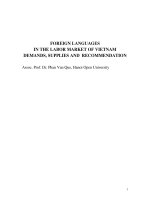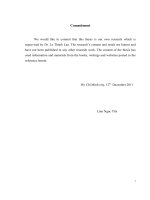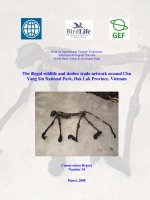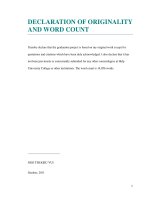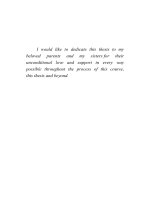the taxonomic study of foliicolous lichenized fungi in chu yang sin national park of vietnam
Bạn đang xem bản rút gọn của tài liệu. Xem và tải ngay bản đầy đủ của tài liệu tại đây (12.21 MB, 73 trang )
I would like to dedicate this thesis to my
beloved parents and my sisters for their
unconditional love and support in every way
possible throughout the process of this course,
this thesis and beyond.
A thesis for Degree of Master of Science
The taxonomic study of
foliicolous lichenized fungi in
Chu Yang Sin national park of Vietnam
Thi Thuy Nguyen
Department of Environmental Education & Science
Graduate School
Sunchon National University
June, 2011
The taxonomic study
of foliicolous lichenized fungi in
Chu Yang Sin national park of Vietnam
Supervisor: Prof. Jae-Seoun Hur
Co-supervisor: Dr. Yogesh Joshi
Presented as a thesis for The Degree of The Master of Science
Thi Thuy Nguyen
Department of Environmental Education & Science
The Graduate School
Sunchon National University
June, 2011
LIST OF CONTENTS
I. Introduction 1
II. Review of literatures 4
1. Foliicolous lichens studies in Vietnam 4
2. Chu Yang Sin national park 4
III. Materials and methods 8
IV. Taxonomy 9
1. Key to foliicolous lichen genera in Chu Yang Sin nation park
9
2. Brief description of genera and their respective species
reported from Chu Yang Sin National Park 10
1) Arthonia 10
Arthonia cyanea var. cyanea 10
2) Bacidina 12
Bacidina apiahica 12
3) Byssoloma 14
Byssoloma chlorinum 15
Byssoloma subdiscordans var. subdiscordans 16
Byssoloma vanderystii 17
4) Calopadia 19
Calopadia puiggarii 20
Calopadia subcoerulescens 21
5) Chroodiscus 23
Chroodiscus mirificus 24
6) Coenogonium 25
Coenogonium dilucidum 26
Coenogonium disciforme 27
7) Echinoplaca 29
Echinoplaca epiphylla 30
Echinoplaca pellicula 31
Echinoplaca tetrapla 32
8) Fellhanera 34
Fellhanera bouteillei 35
Fellhanera emarginata 36
Fellhanera rhapidophylli 37
Fellhanera sublecanorina 38
9) Mazosia 40
Mazosia dispersa 41
Mazosia phyllosema 42
10) Porina 44
Porina alba 45
Porina atriceps 46
Porina conica 47
Porina nitidula 48
Porina rubentior 50
11) Sporopodium 51
Sporopodium phyllocharis 52
Sporopodium xantholeucum 53
12) Strigula 55
Strigula nitidula 56
13) Tricharia 57
Tricharia vainioi 58
V. Conclusion 60
VI. Acknowledgement 62
VII. References 63
VIII. Publications 65
LIST OF FIGURES AND TABLES
Fig. 1. Location of Chu Yang Sin national park in Vietnam 6
Fig. 2. Map of Chu Yang Sin national park
7
Fig. 3. Habit and ascospores of Arthonia cyanea var. cyanea f.
cyanea 11
Fig. 4. Habit and ascospores of Bacidina apiahica 13
Fig. 5. Habit and ascospores of foliicolous species of Byssoloma 18
Fig. 6. Habit and ascospores of foliicolous species of Calopadia 22
Fig. 7. Habit and ascospores of Chroodiscus argillaceus 23
Fig. 8. Habit and ascospores of foliicolous species of Coenogonium
28
Fig. 9. Habit and ascospores of foliicolous species of Echinoplaca 33
Fig. 10. Habit and ascospores of foliicolous species of Fellhanera 39
Fig. 11. Habit and ascospores of foliicolous species of Mazosia 43
Fig. 12. Habit and ascospores of foliicolous species of Porina 49
Fig. 13. Habit and ascospores of species of Porina rubentior 50
Fig. 14. Habit and ascospores of foliicolous species of Sporopodium
54
Fig. 15. Habit and ascospores of species of Strigula nitidula 55
Fig. 16. Habit and ascospores of species of Tricharia vainioi 57
Table 1. The list of orders, families, genera and species in Chu Yang
Sin national park 61
Abstract
The taxonomic study of foliicolous lichenized fungi in
Chu Yang Sin national park of Vietnam
Thi Thuy Nguyen
Department of Environmental Education & Science
The Graduate School
Sunchon National University
Supervisor: Prof. Jae-Seoun Hur
Co-supervisor: Dr. Yogesh Joshi
Foliicolous lichens which known abundant in tropical
regions. While the foliicolous lichen flora was discovered well
in many regions in the world but there were no many
publications deal with the foliicolous lichens from Vietnam.
Twenty eight species belonging to thirteen genera was
recognized from 415 specimens collected from Chu Yang Sin –
a national park located at the Central Highland of Vietnam.
Among them, Byssoloma vanderystii Sérus., Coenogonium
disciforme Papong et al. and Fellhanera emarginata Lücking.
were first time reported from Vietnam. The first fertile
specimens of Coenogonium disciforme Papong et al. was
observed and described in detailed. The key to the genera and
key to species of the genera are given. Each species was
described in diagnostic characters, chemistry and distribution.
Key words: Taxonomy, foliicolous lichenized fungi, Vietnam,
Chu Yang Sin national park
1
I. INTRODUCTION
Foliicolous lichens are lichens that grow on the living leaves
of angiosperms, fern fonds, phyllodes, phylloclades and young
bamboo culms. Generally they occur on the leaves that shed off in 2-
5 years or stayed longer (e.g. Agave and palm leaves), except few
taxa which were found to grow on annually deciduous leaves.
Majority of the foliicolous lichens were found on the upper side of
the leaves i.e. epiphyllous, but few also grow on the lower side i.e.
hypophyllous. Foliicolous lichens generally prefer growing over
leaves of lower branches which not only enjoyed the partial shade of
the over growing branches but also had a more humid environment
than others. Based on their substrate specificity, they can be divided
into three groups:
1) Eufoliicolous lichens: they grow and reproduce entirely
on the leaves and have a crustose thallus that is tightly
adnate to the substrate.
2) Facultative foliicolous lichens: they usually grow on
barks, petioles and twigs but exceptionally on leaves.
3) Pseudofoliicolous (indifferent or ubiquitous) lichens:
besides growing on leaves they can grow on different
substrates, such as rock, bark, soil etc.
The diversity and density of foliicolous lichens is abundant in
the tropical rainforests of Central and South America, Africa and
Southeast Asia, due to availability of optimum temperature, humidy,
sunlight and shade throughout the year. Besides tropical rainforests,
they are also reported from subtropical and temperate rainforests
having humid areas, but the diversity and density in the subtropical
and temperate regions is less in comparison to tropical regions
because of lack of suitable macro- and micro- climatic conditions
responsible for the luxuriance growth of these lichens.
2
These lichens are one of the most abundant epiphytes in
tropical rain forests, henceforth the highest diversity of foliicolous
lichens is found in tropical regions, especially the primary tropical
rainforests which are not affected by anthropogenic disturbance.
More than 800 foliicolous lichen taxa are known from the world.
However, most of the publications mentioning about foliicolous
lichens have came from Neotropics, Valdivian and African
Paleotropic regions, but very few studies were carried out in the
Eastern Paleotropics.
Socialist Republic of Vietnam – a country situated in South
East Asia – with high temperature, high average annual rainfall and
large area of primary tropical rain forests is suitable for the
colonization of tropical lichens, especially foliicolous lichens. The
lichen flora of Vietnam is not well worked out and most of the work
on Vietnamese lichens was done by foreigners during their trip to
Vietnam. Krempelhuber (1873) was the first person to report lichens
from Vietnam, followed by Müller (1891), Harmand (1928), Abbayes
(1964) and Tixier (1966). However, Vĕzda (1977) was the first
person to cite foliicolous lichens from Vietnam, while making a
review on previous publications dealing with lichens of Vietnam.
Aptroot & Sparrius (2006) made a first checklist of lichen flora of
Vietnam and included 32 foliicolous lichen species within it. Later
on, Papong et al. (2007) increased the tally of foliicolous lichens to
70.
Nguyen et al. (2009, 2010) during her studies on foliicolous
lichen flora of Vietnam, reported 14 additional species which were
new to Vietnam lichen flora and raises the tally of foliicolous lichens
to 84. Nguyen et al. (2010) for the first time also reported fertile
specimen of Coenogonium disciforme Papong, Boonpr. & Lücking
from Chu Yang Sin national park of Vietnam. Previously only fertile
specimen of this species was known from Thailand (Papong et al.
2007). Since, there were no expert focusing on this group of lichen in
3
Vietnam, and also number of publications and numbers of species
recorded from this place were very few, this idea led the author to
work on foliicolous lichen flora of Vietnam.
As far as Vietnam is concerned, it is a very big country
located in the Asian wet tropics with long beach and two large deltas
having high annual rainfall making conditions favorable for the
growth foliicolous lichens, henceforth it is bit difficult for the author
to explore entire country within 2 years of time for her Master’s
thesis, that’s why she has focused her study on foliicolous lichen
diversity of Chu Yang Sin national park from where she reported 28
species belonging to 13 genera of which 6 were new to Vietnamese
lichen flora. Key to the genera and species are provided along with
brief description of all the species reported from this national park.
4
II. REVIEW OF LITERATURES
1. Foliicolous lichen studies in Vietnam
In Vietnam, the lichen flora is not discovered well. Some
records were mentioned in some publication of lichens by some
authors in the world. The first species reported of lichens in Vietnam
was in 1873 by Krempelhuber (Krembelhubner, 1873). Following by
Müller (1891), Harmand (1928), Abbayes (1964) and Tixier (1966),
many others species growing on other substrates were reported. Until
1977, Vĕzda made a review on the previous publication dealt with
lichens flora of Vietnam and cited only foliicolous lichens. In his
paper, Vĕzda reported 44 species, increasing the total number of
foliicolous lichens from Vietnam to 63 species in that time. In 2006,
Aptroot & Sparrius (Aptroot & Sparrius, 2006) made a checklist of
lichen flora of Vietnam including 32 foliicolous lichen species. In
2007, Papong et al. (Papong et al., 2007) counted number of total
foliicolous lichens species of Vietnam was 70 species. Until 2010,
Nguyen et al. reported 6 new records of foliicolous lichens in
Vietnam, increase the total species of foliicolous lichen to 76 species.
2. Chu Yang Sin national park
Vietnam, a country located in the Asian wet tropics with long
beach and two large deltas has high annual rainfall that is predictable
of the presence of very high diversity of foliicolous lichens.
Central Highlands or Western Highlands is a highland located
in the central part of Vietnam, including five provinces (Daklak, Dak
Nong, Gia Lai, Kon Tum and Lam Dong provinces). It lays on a
series of contiguous plateaus namely Kon Tum, Mdrak, Daklak, Mo
Nong, Lam Vien and Di Linh plateaus that are surrounded by the
high mountain ranges called Truong Son.
Chu Yang Sin national park which is located in Krong Bong
and Lak Districts of Daklak Province has forests of enormous
5
significance for biodiversity, conservation and protection. Having an
area of 58,947 ha, this is the largest protected area on the Da Lat
Plateau. The park was first designated as a nature reserve in early
1986 and then later upgraded to national park in 2005.
Chu Yang Sin is a system of mountains running from Eastern
North to Western South, and includes Chu Ba Nak Mountain (1,858
m high), Chu Hae’le Mountain (1.204 m), Chu Pan Phan Mountain
(1.185 m), Chu Drung Yang Mountain (1,812 m), Chu Yang Sieng
Mountain (1,128 m), Yang Kling Mountain (1,271 m), Chu Yang
Saone Mountain (1,176 m), Chu Hrang Kreou Mountain (1.071) and
Chu Yang Sin Mountain (2,105 m). There are many small and narrow
valleys but also some flat valleys lying along streams. The elevation
of the park lies between 450 – 2,405 m.
The broadleaved evergreen forest is the dominant vegetation
type in the park with an area of more than 30,000 ha. Lowland semi-
evergreen forests which are characterized by dominance of
Lagerstroemia calyculata and Terminalia nigrovenulosa and lowland
evergreen forests characterized by dominance of Hopea odorata,
Dipterocarpus alatus, Dipterocarpus turbinatus are distributed below
900 m. At elevation above 900 m, submontane and montane
evergreen forests dominated by members of Fagaceae and Lauraceae
are widely distributed. Montane evergreen forests in this region are
characterized mainly by the presence of gymnosperms, such as Pinus
spp., Podocarpus imbricatus and Fokienia hodginsii. On the ridge
line, elfin forest formations dominated by Lyonia annamensis, Lyonia
ovalifolia and the dwarf bamboo Arundinaria sp. are distributed.
Besides this, 65 mammal species are recorded in this park, of
which 12 species are considered globally endangered. 250 bird
species have been confirmed, including 15 threatened and endemic
species. The park also supports impressive richness of reptiles and
6
amphibians with 112 species discovered. Although the fish diversity
is poorly understood, but 81 fish species have been recorded so far.
FIG. 1. Location of Chu Yang Sin National Park in Vietnam.
However, until now, no significant study regarding occurrence
of lichens with in this national park was made by any worker.
Therefore, it is the prime time that lichens, especially foliicolous
lichens, from this national park should be documented and utilized
for the development of a sustainable forest management program.
7
FIG. 2. Map of Chu Yang Sin national park and the locate of the collection ()
This study deals with the identification of foliicolous lichens
collected from Chu Yang Sin national park – a national park located
in Central Highlands of Vietnam. Totally 415 specimens was
checked, 28 species belonging to 13 genera was identified. Key to
genera and keys for species of each genus which has more than one
species that found in this park was provided. Each species was also
described in detailed.
8
III. MATERIALS AND METHODS
Approximately 500 leaf samples bearing various foliicolous
lichen species were collected and examined. Sampling for foliicolous
lichens was performed following the methods outlined by Lücking &
Lücking (1996). The specimens were collected from Chu Yang Sin
national park in the month of February and July, 2010. Because of
biodiversity act and security reasons, the collections were only
permitted to carry out in a small area of this national park (unit 1180).
The leaves bearing foliicolous lichens were cut or plugged out
and then pressed and air dried. Specimens are deposited in the
Korean Lichen Research Herbarium (KoLRI) of Sunchon National
University (SNU).
Identification of the foliicolous lichen specimens was based
on examination of morphological and anatomical features.
Morphology of thallus, vegetative structures, ascomata and
conidiomata were examined under Nikon SMZ 645
stereomicroscope. Hand cut sections for studying anatomical
characters were examined under a Nikon Eclipse E200 microscope.
Beside morphological and anatomical structures, the color
reactions of different parts were tested by the methods described by
Yoshimura (1974): K (10% aqueous KOH solution), I (Lugol’s
solution), KI (10% KOH followed by Lugol’s solution).
Microcrystallography and thin layer chromatography (Culberson
1972) was also carried out to identify the chemical compounds met
within the species that needs those tests for identification.
9
IV. TAXONOMY
1. Key to foliicolous lichen genera in Chu Yang Sin national
park
1) Ascomata perithecia 2
Ascomata apothecia 3
2) Asci functionally unitunicate, entirely thin-walled Porina
Asci functionally bitunicate, apically thick-walled Strigula
3) Apothecia immersed-erumpent or spot-like 4
Apothecia sessile 7
4) Apothecia immersed-erumpent 5
Apothecia spot-like 6
5) Apothecia disc dark grey to black, margin smooth, not prominent,
ascospores has median cell slightly enlarged Mazosia
Apothecia disc light grey to orange-red, margin with recurved,
triangular lobes, prominent Chroodiscus
6) Photobiont trentepohlioid, asci bitunicate, Arthonia
Photobiont chlorococcoid, asci annellascaceous or lecanoroid
Echinoplaca
7) Hymenium non-amyloid 8
Hymenium amyloid 9
8) Photobiont trentepohlioid, ascospores 1-septate Coenogonium
Photobiont chlorococcoid Tricharia
9) Ascospores narrowly cylindrical to filiform Bacidina
Ascospores ellipsoid-fusiform to cylindrical 10
10) Excipulum composed of free, loosely interwoven hyphae, usually
byssoid Byssoloma
Excipulum prosoplectenchymatous or paraplectenchymatous or
excipulum absent 11
11) Conidiomata pycnidia Fellhanera
Conidiomata campylidia 12
12) Thallus continuous or laciniate, greenish to bluish grey, rich in
secondary compounds, conidia oblong-ellipsoid to drop-shaped
Sporopodium
Thallus dispersed into rounded patches, conidia filiform with clavate
apex Calopadia
10
2. Brief description of genera and their respective species
reported from Chu Yang Sin National Park
1) Arthonia Ach., Neues J. Bot. Erfurt 1: 3. 1806
The genus Arthonia belongs to family Arthoniaceae and is
characterized by dispersed or continuous, ecorticate, smooth or rarely
verrucose thallus; photobiont trentepohlioid (Phycopeltis); apothecia
adnate and spot-like or rarely lirellate; paraphyses branched and
anastomosing; ascospores transversely septate to muriform, colorless
to greyish brown; pycnidia rounded, conical to applanate; conidia
ellipsoid to cylindrical, non-septate to transversely septate, colorless.
So far 4 species pertaining to this genus are reported from
Vietnam of which 1 is foliicolous.
Arthonia cyanea var. cyanea f. cyanea Müll. Arg., Flora 64: 233. 1881.
Diagnostic characters: Thallus dispersed into rounded patches,
smooth, 10–15 mm across, 8–10 µm thick, ecorticate, greenish grey,
matt. Photobiont cells rectangular in radiate plates, 8–14 × 3–5 µm.
Apothecia rounded, 0.4–0.8 mm diam., 30–37 µm high, dark bluish
grey but with white pruina. Hypothecium 3–4 µm high, colorless, I+
yellow, KI+ pale yellow. Epithecium colorless to sordid green
granules, 5–7 µm high, I+ yellow. Hymenium 20–30 µm high,
colorless, I+ orange-red, KI+ yellow. Asci obovate to globose, 20–25
× 18–23 µm, I–. Ascospores clavate, 3-septate, constricted at septa,
15–25 × 4–6 µm, distal cell enlarged, colorless. Conidiomata not
seen.
Chemistry: unknown substance detected in solvent A.
Distribution: Pantropical.
Remarks: A. cyanea var. cyanea f. cyanea can be easily
recognized by pruinose and large apothecia and 3-septate ascospores.
FIG. 3
Habit and ascospores of
A.
Thallus with ascomata.
The species is not confused with
belonging to the genus
differs in having rounded, non
apothecia and 2-
septate ascospore
Specimens
examined: Vietnam, Daklak Prov., Chu Yang Sin
National Park. 12°28'22.8" N 108°20'32.8" E,
July 2010, Thi-Thuy Nguyen
100463, 100471, 100487, 100488,
100489, 100504, 100513, 100515, 100516, 100525 (KoLRI);
12°27'07.7" N
108°20'21.7" E, alt. 776 m, on leaf, 04 July 2010,
Thuy Nguyen 100621 (KoLRI).
1 cm
11
Habit and ascospores of
Arthonia cyanea var. cyanea.
Thallus with ascomata.
B. Ascospores
The species is not confused with
A. accolens – another species
differs in having rounded, non
-pruinose
septate ascospore
s.
examined: Vietnam, Daklak Prov., Chu Yang Sin
National Park. 12°28'22.8" N 108°20'32.8" E,
alt. 430 m, on leaf, 01
100463, 100471, 100487, 100488,
100489, 100504, 100513, 100515, 100516, 100525 (KoLRI);
108°20'21.7" E, alt. 776 m, on leaf, 04 July 2010,
Thi-
1
0
µ
m
12
2) Bacidina Vězda, Folia Geobot. Phytotax. 25: 431. 1990.
The genus Bacidina belongs to the family Ramalinaceae and
is characterized by crustose, continuous, ecorticate, greenish to pale
green thallus, photobiont chlorococcoid or cyanobacteria; apothecia
sessile, rounded, pale yellow to dark brown, margin biatorine,
excipulum paraplectenchymatous, hypothecium colorless, hymenium
colorless, I+ dark blue then aeruginous and can be dark brown,
paraphyses unbranched; ascospores ellipsoid to filiform, tapering
towards proximal end, non-septate to transversely septate, colorless;
pycnidia sessile, subglobose to tubular or stipitate, conidia filiform,
transversely septate, colorless.
Two species of the genus were reported occurring in Vietnam
and both are foliicolous and only one species was found in this study.
Bacidina apiahica
(Müll. Arg.) Vězda, Folia Geobot. Phytotax. 25: 432. 1990.
Diagnostic characters: Thallus continuous, 10–40 mm across,
15–18 µm thick, farinose, greenish grey to pale green. Photobiont
chlorococcoid, cells 5–10 µm diam. Apothecia sessile, rounded, 0.2–
0.5 mm diam., 120–200 µm high; disc plane to slightly convex, pale
yellow to ochraceous or orange-yellow; margin thin, same color as
disc or paler. Excipulum 30–35 µm broad. Hypothecium 20–40 µm
high, colorless. Hymenium 35–45 µm high, colorless. Asci clavate,
35–40 × 6–7 µm. Ascospores arrange in bundle, bacillar, tapering
towards proximal end, 3-septate, without constrictions at septa, 25–
40 × 1.5–2 µm, 15–20 times as long as broad, colorless. Pycnidia
tubular, 0.1–0.15 mm high, 35–50 µm broad, pale yellow. Conidia
filiform, curved and tapering towards ends, 3-septate, 40–70 × 0.8–
1.2 µm, colorless.
FIG. 4
Habit and ascospores of
A.
Thallus with apothecia;
Chemistry:
No substances detected by TLC.
Distribution: Pantropical
, extending into subtropical and wet
temperate zones.
Remarks:
This species is easily recognized by
isidia,
yellowish to orange apothecia that produce filiform ascospores
having the length of 20–
40 µm and
another species of Bacidina
differ
7-septate ascospores.
Specimens
examined: Vietnam
National Park. 12°27'08.4"
N 108°20
July 2010, Thi-Thuy Nguyen
108°20'33.3" E,
alt. 693 m, on leaf,
100717 (KoLRI).
0.5 c
13
Habit and ascospores of
Bacidina apiahica
Thallus with apothecia;
B. Ascospores.
No substances detected by TLC.
, extending into subtropical and wet
-
This species is easily recognized by
thallus lacking
yellowish to orange apothecia that produce filiform ascospores
40 µm and
3 septa. B. pallidocarnea –
differ
s in having longer (40–60 µm), 3–
examined: Vietnam
, Daklak Prov., Chu Yang Sin
N 108°20
'20.1" E, alt. 774 m, on leaf, 03
100564 (KoLRI); 12°28'16.1" N
alt. 693 m, on leaf,
06 July 2010, Thi-Thuy Nguyen
0.5 c
m
25
µ
m
14
3) Byssoloma Trevis., Spighe Paglie: 6. 1853.
The genus Byssoloma belongs to the family Pilocarpaceae.
The three other genera that also belong to this family found in Chu
Yang Sin national park are Fellhanera, Calopadia and Sporopodium.
The species of Byssoloma can be recognized by dispersed or
continuous, smooth to farinose thallus of various colors; photobiont
chlorococcoid, apothecia sessile to adnate, rounded; margin biatorine,
usually byssoid and spreading over thallus surface; excipulum usually
composed of free loosely interwoven hyphae, hypothecium
prosoplectenchymatous, brown; hymenium colorless, I+ dark blue;
paraphyses branched and anastomosing; asci clavate, Byssoloma-
type, 8-spored; ascospores ellipsoid to cylindrical, transversely
septate, colorless; pycnidia sessile, hemispherical to wart-shaped;
conidia usually pyriform, non-septate, colorless.
There were 4 species of this genus found in Vietnam.
Key to foliicolous species of Byssoloma
in Chu Yang Sin national park
1. Ascospores 7-septate B. vanderystii
Ascospores 3-septate 2
2. Apothecia blackish brown, greyish white margin
B. chlorinum
Apothecia pure black, pure white margin
B. subdiscordans f. subdiscordans
15
Byssoloma chlorinum (Vain.) Zahlbr., Catal. Lich. Univ. 8: 233. 1932
Diagnostic characters: Thallus continuous, 7–15 mm across,
17–20 µm thick, minutely farinose, pale green. Apothecia sessile,
rounded, 0.3–0.5 mm diam., 100–120 µm high; disc plane, brownish
black; margin densely byssoid, white, spreading laterally over thallus
surface. Excipulum well-developed, made of loosely woven hyphae,
50–80 µm broad, colorless. Hypothecium 15–20 µm high, dark brown,
K–. Apothecial base brownish black. Hymenium 40–45 µm high,
colorless. Asci 35–42 × 8–10 µm. Ascospores oblong-ellipsoid, 3-
septate, non-constricted at septa, 10–13 × 2.5–3 µm, 3–4 times as
long as broad, colorless. Pycnidia subglobose, 0.1–0.15 mm diam.,
grey. Conidia pyriform, non-septate, 3–4 × 1–1.5 µm, colorless.
Chemistry: No substances detected by TLC.
Distribution: Pantropical.
Remarks: In the genus Byssoloma, B. chlorinum is the most
common species in the area. This species is characterized by the
green thallus with small apothecia (0.2–0.5 mm diam.) which has
grey white margin and blackish brown disc and 3-septate ascospores.
Specimens examined: Vietnam, Daklak Prov., Chu Yang Sin
National Park. 12°27'07.7" N 108°20'21.7" E, alt. 776 m, on leaf, 04
July 2010, Thi-Thuy Nguyen 100600, 100642, 100644, 100648,
100653 (KoLRI); 12°28'16.1" N 108°20'33.3" E, alt. 693 m, on leaf,
06 July 2010, Thi-Thuy Nguyen 100711, 100719 (KoLRI).
16
Byssoloma subdiscordans var. subdiscordans (Nyl.) P. James,
Lichenologist 5: 126. 1971.
Diagnostic characters: Thallus dispersed into rounded patches,
5–10 mm across, 20–22 µm thick, green. Apothecia sessile, rounded,
0.3–0.5 mm diam., 120–200 µm high; disc plane to slightly convex,
pure black; margin well-developed, densely byssoid, pure white,
persistent and spreading laterally over thallus surface. Excipulum
well-developed, made of loosely woven hyphae, 50–130 µm broad,
colorless. Hypothecium 20–30 µm high, dark brown with purplish
tingle, K+ purplish. Apothecial base purplish brown. Epithecium 5–7
µm high, blackish brown. Hymenium 40–45 µm high, colorless. Asci
35–40 × 10–12 µm. Ascospores oblong-ellipsoid, 3-septate, non-
constricted at septa, 10–15 × 3–5 µm, 3–3.5 times as long as broad,
colorless. Pycnidia not observe.
Chemistry: No substances detected by TLC and HPLC.
Distribution: Cosmopolitan.
Remarks: B. subdiscordans f. subdiscordans can be easily
distinguished with other species which has 3-septate ascospores
found in Chu Yang Sin National Park such as B. chlorinum by typical
pure black apothecia with pure white margin. Besides that, it has
thallus that dispersed into rounded patches, slightly shiny and has
corticiform layer.
Specimens examined: Vietnam, Daklak Prov., Chu Yang Sin
National Park. 12°28'22.8" N 108°20'32.8" E, alt. 430 m, on leaf, 01
July 2010, Thi-Thuy Nguyen 100475, 100507 (KoLRI); 12°27'08.4"
N 108°20'20.1" E, alt. 774 m, on leaf, 03 July 2010, Thi-Thuy Nguyen
100559 (KoLRI); 12°27'07.7" N 108°20'21.7" E, alt. 776 m, on leaf,
04 July 2010, Thi-Thuy Nguyen 100600 (KoLRI);
17
Byssoloma vanderystii Sérus., Lichenologist 11: 181. 1979.
Diagnostic characters: Thallus continuous, 12–18 mm across,
smooth, greenish grey. Apothecia sessile to adnate, rounded, 0.3–0.5
mm diam., 150–180 µm high; disc slightly to strongly convex,
chocolate-brown with a paler reddish brown marginal zone; margin
well developed, densely byssoid, spreading laterally over thallus
surface, chamois-colored. Excipulum made of loosely woven hyphae,
100–200 µm broad, colorless. Hypothecium 57–60 µm high, brown,
K–. Epithecium indistinct. Hymenium 90–95 µm high, colorless. Asci
75–80 × 12–14 µm, 8 ascospores per ascus. Ascospores cylindrical,
7–septate, non-constricted at septa, 25–28 × 3–4.5 µm. Pycnidia not
observed.
Chemistry: no substances detected by TLC.
Distribution: Pantropical.
Remarks: Byssoloma vanderystii is the only species found in
Chu Yang Sin National Park has long 7-septate ascospores while two
other Byssoloma species has 3-septate ascospores. Further more, B.
vanderstii has convex apothecia with chocolate-colored disc.
Specimens examined: Vietnam, Daklak Prov., Chu Yang Sin
National Park. 12°27'07.7" N 108°20’21.7" E, alt. 776 m, on leaf, 04
July 2010, Thi-Thuy Nguyen 100652 (KoLRI); 12°28'16.1" N
108°20'33.3" E, alt. 693 m, on leaf, 06 July 2010, Thi-Thuy Nguyen
100684, 100712 (KoLRI); 12°26'24.6" N 108°20'22.1" E, alt. 761 m,
on leaf, 06 July 2010, Thi-Thuy Nguyen 100761 (KoLRI);
12°26'59.8" N 108°20'24.3" E, alt. 767 m, on leaf, 08 July 2010, Thi-
Thuy Nguyen 100788 (KoLRI);
